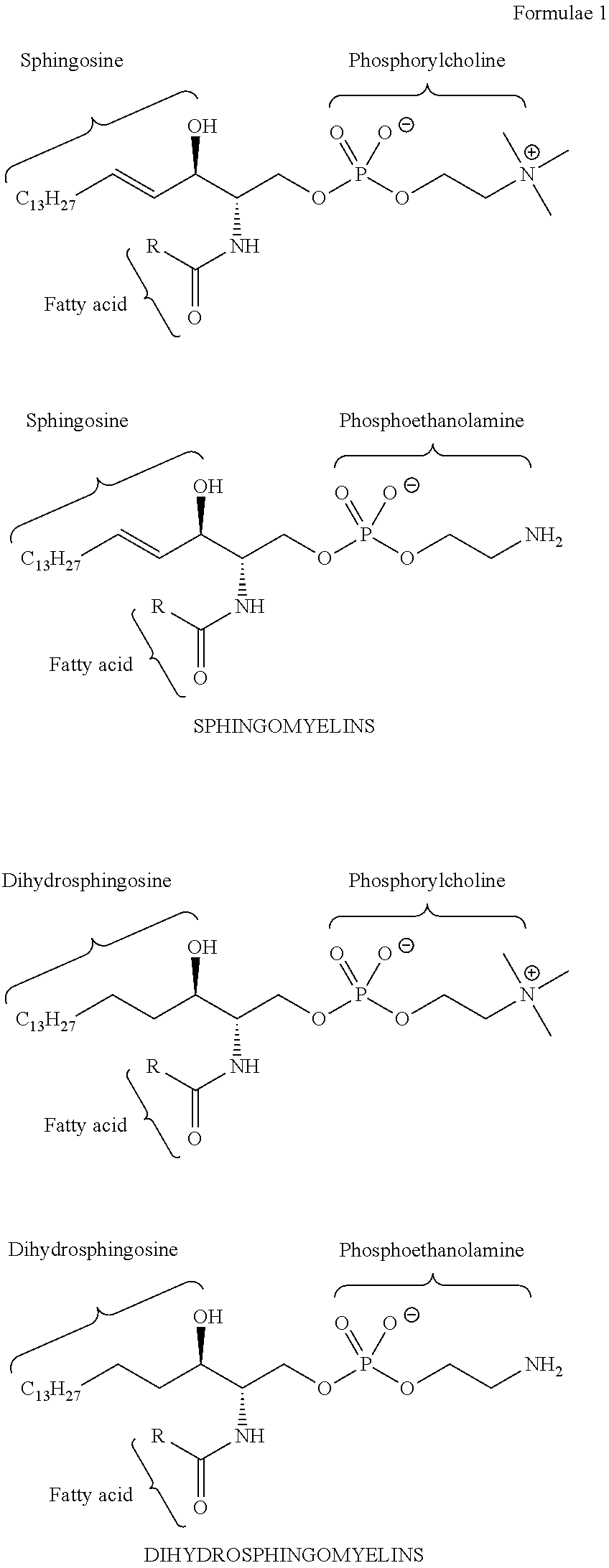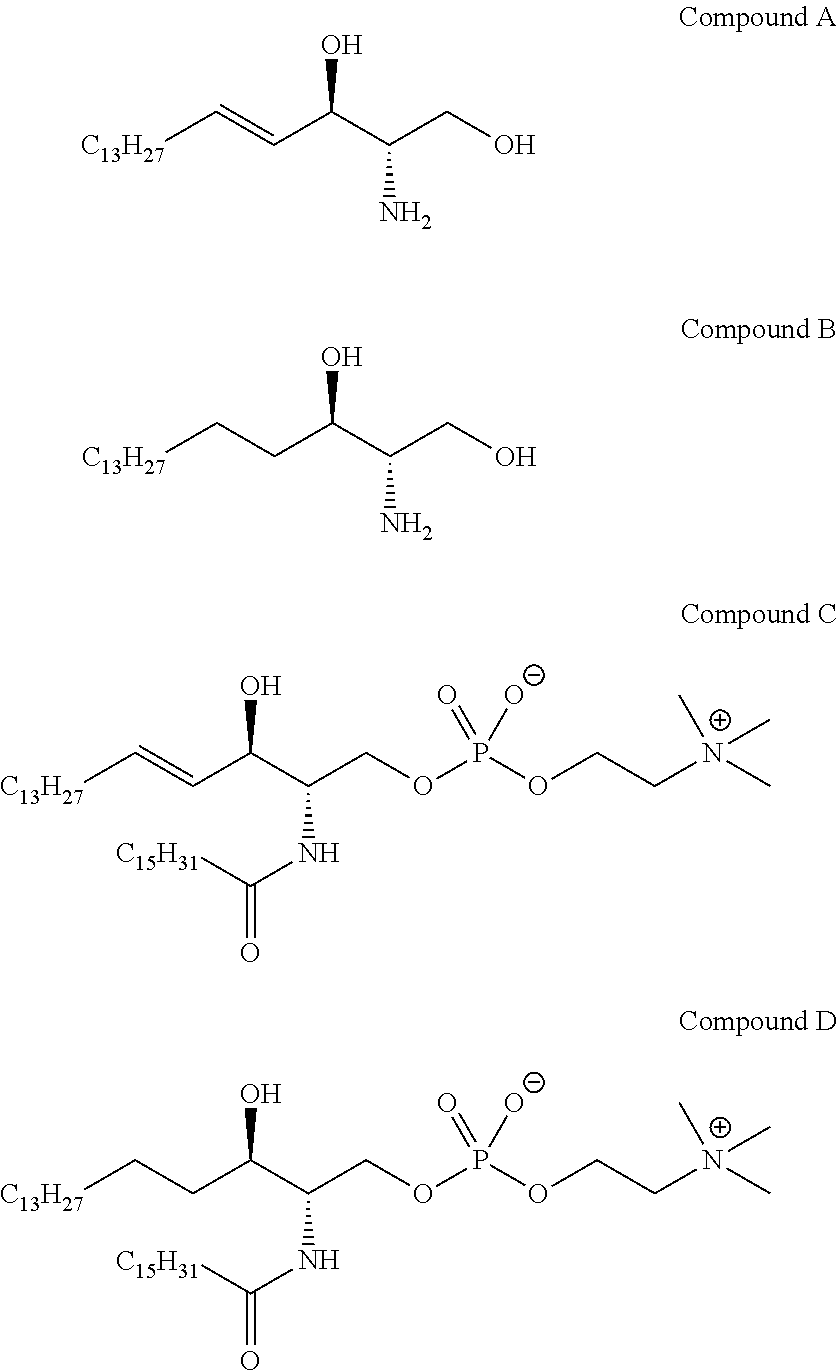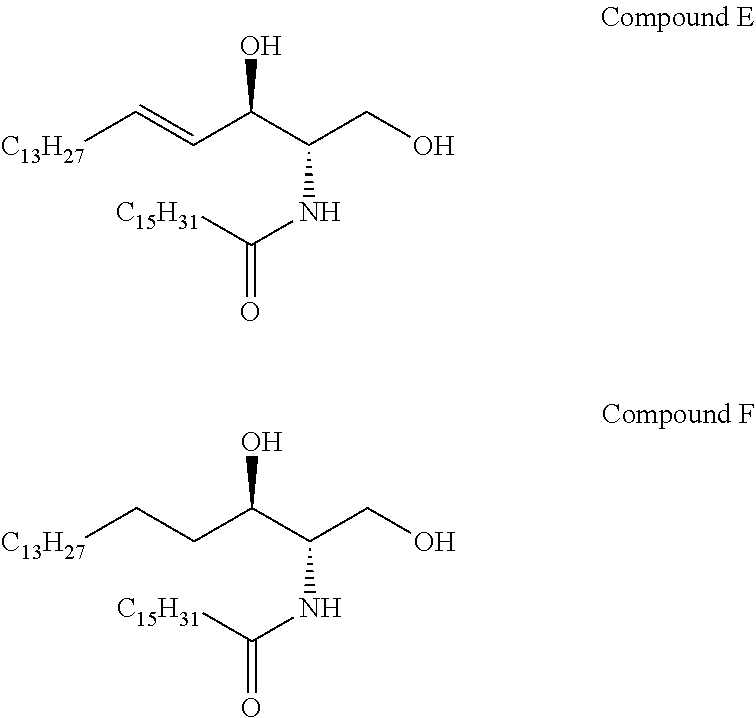Methods for the synthesis of sphingomyelins and dihydrosphingomyelins
a technology which is applied in the field of methods for the synthesis of sphingomyelin and dihydrosphingomyelin, can solve the problems that the synthetic pathway known in the art has not been useful for the large-scale synthesis of sphingomyelin
- Summary
- Abstract
- Description
- Claims
- Application Information
AI Technical Summary
Benefits of technology
Problems solved by technology
Method used
Image
Examples
example 1
Synthesis of N-Palmitoyl-D-erythro-sphingomyelin via (1R,2R,5R)-(+)-2-hydroxy-3-Pinanone
Step 1: Synthesis of 2-(E)-Hexadecenal
Step 1.1: 1-Tetradecanal
[0236]
[0237]To a solution of 1-tetradecanol (110.0 g; 0.513 mol) and trichloroisocyanuric acid (178.1 g; 0.77 mol) in methylene chloride (1500 ml) at −30° C. was added (2,2,6,6-Tetramethylpiperidin-1-yl)oxyl (TEMPO) (800 mg; 0.051 mol). The reaction mixture was stirred for 1.5 h at 0° C. and filtered on celite. The organic phase collected was then washed with a saturated solution of Na2CO3 (800 ml) followed by HCl 1N (800 mL). It was then dried over MgSO4, filtered and concentrated under vacuum to give rise to the title compound as white solid (99.6 g; 91%).
Step 1.2: Ethyl-2-Hexadecenoate
[0238]
[0239]To a suspension of NaH (2.4 g, 0.059 mol) in anhydrous tetrahydrofuran (40 mL) triethylphosphonoacetate (9.4 mL, 0.047 mol) was added, dropwise, at 0° C. After stirring for 30 minutes at 0° C., a solution of tetradecanal (10.0 g, 0.047 mol)...
example 2
Lab-Scale Synthesis of N-Palmitoyl-D-Erythro-Sphingomyelin Starting from D-erythro-Sphingosine
Step 1: D-erythro-Ceramide-C16
[0294]
[0295]Palmitic acid (17.12 g, 66.8 mmol) and D-erythro-sphingosine (20 g, 66.8 mmol) in tetrahydrofuran (890 ml) were added to a suspension of O-Benzotriazole-N,N,N′,N′-tetramethyl-uronium-hexafluoro-phosphate (27.84 g, 73.4 mmol) in 140 ml dimethylformamide. The obtained white suspension was cooled at 0-5° C., 22.5 ml (160.7 mmol) triethylamine was added over the course of 30-60 min, and the mixture was stirred at room temperature for 12 h. After this time the thin layer chromatography (TLC) analysis indicated >99% conversion to D-erythro-ceramide-C16. Citric acid 5% (400 ml) was added, the mixture was stirred for 30 min at 0-5° C. and the obtained suspension was filtered. The white cake was suspended in water (600 ml) at room temperature. The suspension was filtered and washed with water. Drying for 12 hours at reduced pressure at 40° C. gave 32.4 g (yi...
example 3
Pilot-Scale Synthesis of Palmitoyl Sphingomyelin via (S)-3-(tert-Butoxycarbonyl)-4-(1-oxo-hexadec-2-enyl)-2,2-dimethyloxazolidine
Step 1: Boc-L-Ser-OMe
[0309]32.2 kg L-Ser-OMe.HCl (206.97 mol) was suspended in 288 kg ethyl acetate in a 630 L vessel and cooled to 2° C. Triethylamine (24.1 kg, 238.17 mol, 1.15 eq.) was added followed by a solution of Boc2O (51.9 kg, 237.80 mol, 1.15 eq.) in 24 kg ethyl acetate. The reaction mixture was warmed to 22° C. and stirred overnight. TLC analysis showed a content of L-Ser-OMe.HCl of less than 1%. 114 L purified water was added and the phases were separated. Washing was repeated twice with 114 L purified water. The three aqueous phases were combined and extracted with 102 kg ethyl acetate. TLC analysis indicated absence of product in the aqueous phase. The two organic phases were combined and evaporated to dryness at 60° C. 88 kg toluene was added to the residue and distilled off at 60° C. This procedure was repeated. Purity of crude Boc-L-Ser-OM...
PUM
| Property | Measurement | Unit |
|---|---|---|
| Fraction | aaaaa | aaaaa |
| Polarity | aaaaa | aaaaa |
Abstract
Description
Claims
Application Information
 Login to View More
Login to View More - R&D
- Intellectual Property
- Life Sciences
- Materials
- Tech Scout
- Unparalleled Data Quality
- Higher Quality Content
- 60% Fewer Hallucinations
Browse by: Latest US Patents, China's latest patents, Technical Efficacy Thesaurus, Application Domain, Technology Topic, Popular Technical Reports.
© 2025 PatSnap. All rights reserved.Legal|Privacy policy|Modern Slavery Act Transparency Statement|Sitemap|About US| Contact US: help@patsnap.com



